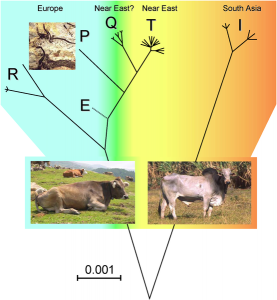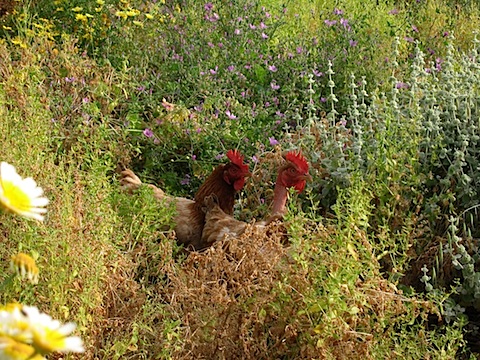- The looming P crisis. As is there’s not enough to worry about.
- Water pest makes itself useful in the Philippines.
- “To promote real Oscypek, Zakopane’s tourism bureau has created a special tour allowing visitors to find the mountain meadow huts of 25 baca cheesemakers.” Sign me up.
Size matters
A few days ago I posted a link to an article on miniature cows on the DAD-Net mailing list of the livestock genetic resources conservation community. Here’s the gist of that piece, which appeared in the LA Times:
…miniature Herefords consume about half that of a full-sized cow yet produce 50% to 75% of the rib-eyes and fillets, according to researchers and budget-conscious farmers.
…
In the last few years, ranchers across the country have been snapping up mini Hereford and Angus calves that fit in a person’s lap. Farmers who raise mini Jerseys brag how each animal provides 2 to 3 gallons of milk a day, though they complain about having to crouch down on their knees to reach the udders.
…
Minicows are not genetically engineered to be tiny, and they’re not dwarfs. They are drawn from original breeds brought to the U.S. from Europe in the 1800s that were smaller than today’s bovine giants, said Ron Lemenager, professor of animal science at Purdue University in West Lafayette, Ind.
This elicited quite a discussion on DAD-Net, set off by a suggestion that such smaller breeds of livestock might be useful in the Pacific Island Islands and Territories (PICTs), which have very limited resources for livestock production.
One contributor pointed out that the amount of feed consumed is not the only consideration:
Minature breeds are possibly fine for subsistence or local supply oriented production systems (which some PICT systems are, but possibly also important to consider how good such systems are at satisfying local or subsistence demands as well)…
They are, however, less efficient to process for commercialized production systems because it costs almost the same to slaughter and process a miniature as it does to slaughter and process a larger animal of the same species.
Once again, for me it is really an issue of fitness for purpose and I, therefore, believe diversification is the real answer.
Another pointed out that just because an animal consumes less doesn’t mean it consumes more efficiently:
The idea of considering miniature breeds of livestock for PICTs is a bit tricky. Animal size is naturally related to structure and function of the body, so the issue is about scaling… In short, smaller body size may require less volume of inputs but it is not necessarily more efficient in using these inputs in comparison with larger sizes of the same type.
…
The miniature breed of cattle referred to in the article (Hereford) is neither dwarf nor genetically engineered. They are a genetically improved beef animal also selected for their miniature body size apart from their desirable beef characteristics. They belong to an established commercial beef breed, and as such they are as demanding in terms of their input requirements to attain their top performance as are their bigger competitors, although in smaller amounts.
Another participant thought PICTs should make the most of what they already have:
I am simply of the opinion that PI countries stay with what breeds (appropriate exotic, exotic-cross locals), but make the necessary improvements where currently needed i.e. management, feed, breeding, animal health as well as the needed slaughter and meat inspection requirements.
But one did think there was a place for miniature livestock:
Miniature breeds for livestock production would be ideal to other PICTs while others may at this time not yet ready for such undertakings, since adaptability, management, husbandry and acceptance of the particular species or breeds to the local communities are yet to be researched into.
Finally, a couple of people objected to the word “miniature” itself:
I suggest that we avoid using the term “miniature” cows because this can be misleading. It is the terminology and what it is associated with that stands out more than the fundamental issues being raised in this debate. We have stigmatized a number of breeds because of issues of size, production and markets without consideration of the context. It is always important to put things in the right context.
Which is a pretty good note to end this summary on. The importance of context and of a diversity of options are things we like to talk about here. I just wish there was a place for similar discussion of plant genetic resources conservation issues…
Climate change to devastate crops, promote livestock
[B]y 2050, hotter conditions, coupled with shifting rainfall patterns, could make anywhere from 500,000 to one million square kilometers of marginal African farmland no longer able to support even a subsistence level of food crops. However, the land, on which some 20 to 35 million people currently live, may still support livestock.
Boosting livestock production could be an attractive alternative for millions of poor farmers across Africa who, in the coming decades, could find that climate change has rendered their lands unsuitable for crop cultivation yet still viable for raising animals, according to the study that appears this week in a special edition of the journal Environmental Science and Policy.
That’s from a press release put out by ILRI, the International Livestock Research Institute. The paper is from a special issue of Environmental Science and Policy on Food Security and Environmental Change, Food Security and Environmental Change: Linking Science, Development and Policy for Adaptation. Just skimming the contents gives me the willies.
By the way, Wikipedia says sub-Saharan Africa covers an area of 24.3 million square kilometers. It doesn’t say how much of that supports a subsistence level of food crops. So it is hard to know how much difference this prediction will really make.
Aurochs alive and well
Well, not quite. But some of their DNA is. A paper just out in PLoS ONE has found two mitochondrial DNA haplogroups (the ones labelled R and P in the diagram below) which apparently got into Italian local breeds from “European aurochsen [haplogroup E] as the result of sporadic interbreeding events with domestic herds grazing in the wild.” Some of these breeds are rare and marginalized, though, so even the last remnants of the aurochs might be in danger.

Semi-naked chicks go wild on Crete
“Eeyew. What’s wrong with that chicken?”
We were sitting on the shaded verandah of Nico, a lovely man who, after training as an architect in the US, chucked it all in to live off the grid and as sustainably as possible in a converted hovel in the west of Crete. No electricity, no running water, a wild garden and wilder chickens foraging through it.
Naturally I peered at the chicken, and there it was: naked-necked as I live and breathe.

“Golly, a naked-necked chicken, here on Crete.”
Nico, meanwhile, was answering my friend, and explaining that it was that way naturally and didn’t seem to be any different from the other chickens in his flock.
I waded in with information about the naked-necked chickens of Transylvania and elsewhere, citing the very latest thoughts on the subject, to-whit:
The use of single or combined dominant genes for feather restriction (Na) and feathering structure (F), as well as the sex-linked recessive gene for reduced body size (dw), has been found to be particularly relevant for the tropics (Horst, 1989; Haaren-Kiso et al., 1995). Research into the effects of these genes on economic factors has been undertaken in Malaysia (Khadijah, 1988; Mathur and Horst, 1989). For example, the feather restriction (Na) or Naked Neck gene results in 40 percent less feather coverage overall, with the lower neck appearing almost “nakedâ€. This considerably reduces the need for dietary nutrition to supply protein input for feather production, and protein is a limiting factor in many scavenger feed resource bases. Barua et al., (1998) has reviewed the available information on the performance of indigenous Naked Neck fowl in the hope that it will draw the attention of scientists worldwide to its interesting characteristics and facilitate future research.
I asked Nico whether the naked-necked birds were more efficient egg layers, or suffered less in the heat, but he didn’t know. I said I’d be happy to return to conduct a thorough investigation, but I haven’t had a reply yet.
The photo took some doing too, the birds treating me as an overlarge predator definitely up to no good. Which they should.